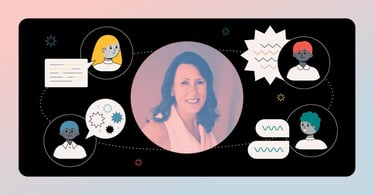DISC Selling Skills for Reflective Communicators
Everyone is going to have to "sell" at some point in their professional lives, be it pitching an idea, making your case for a promotion, seeking a deeper connection with a peer, or literally selling a product or idea. This might not come naturally to all behavioral types but understanding the DISC (behavioral) styles of people around you can help immensely.
This blog series will review each DISC type and how they can best interact and "sell" to the other behavioral types. Let's take a look at the Reflective behavioral style or a low D communication style.
The Reflective Communicator In-Depth
Reflective communicators are cooperative, low-key, modest, and mild. They tend to engage people by being agreeable and thoughtful when focusing on an outcome. They prefer clear and thorough communication but their mild demeanor and aversion to conflict can lead to unclear communication.
They can also struggle in sales roles since they aren't a fan of the 'hard sell' and instead prefer to make genuine connections. Fortunately, when utilized correctly, this peaceful cooperative approach can be leveraged as a strength in the sales process.
Here's how Reflective communicators can sell to every DISC type.
Reflective Communicators Selling to Direct Communicators (High D)
The Direct communicator is looking for results. Direct communicators are ambitious, forceful, and pioneering.
They tend to seek out leadership positions and enjoy clear, productive conversations. They value results over enthusiasm; the motto, "Be brief, be bright, be gone!" is well applied here.
The Reflective communicator needs to stand their ground in this interaction.
If you're a low D, you need to make sure you are well-prepared and have anticipated different possible outcomes — a Direct communicator might jump quickly from topic to topic and will expect their salesperson to keep up.
Low Ds need to avoid hesitating and coming across as unsure; make your case clearly, explain value and how it will benefit the high D, and then outline next steps as you close.
Reflective Communicators Selling to Reflective Communicators (Low D)
The Reflective communicator is looking for an agreement. Obviously, this combination is an excellent match for Reflective selling skills! Since both parties are agreeable and looking for a mutually beneficial outcome, present your case clearly for best results.
Make sure to build extra time into the sales process — the Reflective communicator will want time and space to consider their options and weigh outcomes.
They also are looking for genuine connections, so be yourself! Think about how you'd like to be treated on a sales approach and proceed with an open mind and open communication.
Create openings for them to share their opinion without being put on the spot — they will appreciate the chance to share their point of view!
Reflective Communicators Selling to Outgoing Communicators (High I)
The Outgoing communicator is looking for the experience of a postive interaction.
Outgoing communicators are people-oriented, enthusiastic, and skilled negotiators. You might think that they are a poor match for Reflective communicators but that's not necessarily true.
Outgoing communicators are very people focused and want to make real connections and have a positive experience with others — Reflective communicators share those traits!
Low Ds will have a successful sale to High I communicators if they can keep them from being distracted. Outgoing communicators want to have a good time, so keep the sales experience enjoyable for them by asking for feedback and engaging them throughout.
Also make sure to let them set the pace of the interaction; they might be bouncing off the walls with energy or they might be looking to make a deeper connection with the Reflective seller.
Either way, make sure to follow up with action steps in writing, and reinforce your desired outcome in a summary with clear objectives.
Reflective Communicators Selling to Reserved Communicators (Low I)
The Reserved communicator is looking for mutual benefit.
Reserved communicators are restrained, controlled, and reflective. They prefer to be socially discreet and can struggle to engage with styles very different from their behavioral style.
The good news is that Reflective communicators are well suited to match their energy and create a productive and supportive sales environment.
Bring Reserved communicators a clear plan of action and stick to specifics — how does your solution solve their problem? Don't over promise or aggrandize and keep the interaction short, backed by facts, and friendly in a low-key way.
Reflective communicators need to take charge of this interaction, which is likely out of their comfort zone but will bring the best possible outcome.
Finally, give the Reserved communicator time to think and make a decision on their own —- they'll appreciate having space and time to consider their options.
Reflective Communicators Selling to Steady Communicators (High S)
The Steady communicator is looking for understanding.
Steady communicators prefer a slow pace, defined responsibilities, and clearly outlined expectations. They are considerate, compassionate, and accepting of others, but might seem indifferent or hesitant on the surface.
There's usually a lot of overlap between high Ss and low Ds. That means Reflective communicators are in a good position to make an advantageous sale, but doing so relies on sticking to an agreed upon expected timeline for both parties.
Steady communicators want lots of notice of due dates and decisions and will likely put both off if possible, so make sure to stick to your timeline. Let them know a long way ahead of time when a decision needs to be made and ask open ended questions to draw them out.
Don't expect a fast sale and make sure to hold your ground! Steady communicators will appreciate your consistency and giving them time to decide.
Reflective Communicators Selling to Dynamic Communicators (Low S)
The Dynamic communicator is looking for new ideas.
Low S communicators are open and confident about sharing information, and they prefer lively, fast-paced conversation. This rapid-fire pace can overwhelm Reflective communicators and make for a negative interaction.
This is honestly a poor match for both low Ds and low Ss, so the Reflective salesperson needs to be prepared to over-adapt for success on both sides.
Keep your pitch and presentation short, and make sure your timeline is fast-paced and full of bold moves, since the low S can become impatient. Reflective communicators need to be ready to discuss multiple topics in a single conversation — let them think out loud!
By doing this, you can create multiple pathways for the Dynamic communicator to reach your desired outcome while letting them lead the way.
Reflective Communicators Selling to Precise Communicators (High C)
The Precise communicator is looking for information.
Precise communicators are dependent, neat, careful, and compliant. They want to get the job done right and thrive on established systematic processes to follow in the workplace.
The Reflective communicator will have the most possible success in this sale if they demonstrate an organized and objective approach.
Get specific in this conversation! Demonstrate that you're making decisions around facts, not emotions, and don't be vague with your plans or intentions.
High Cs will be looking for inconsistencies, so make sure your messaging is solid, accurate and well-researched. Give them enough time to verify your pitch and don't ask them to make a decision on the spot.
Reflective Communicators Selling to Pioneering Communicators (Low C)
The Pioneering communicator is looking for a vision.
Pioneering communicators are independent, unconventional, experimental, and outspoken. They can roll with the punches and adjust on the fly and might even prefer to do so instead of adhering to rigid guidelines or rules, so make sure that you can be flexible while keeping your end goal in sight.
This might sound counterproductive, but letting a low C get off topic can lead to the best possible outcome.
They thrive when they're coming up with non-conventional solutions, so present your ideal outcome and work backward with them — find a path to success together and let their input contribute.
That being said, you do need to make sure to clearly outline next steps and summarize outcomes for the future to stay on track and follow up with details in writing.
Make the Sale the Reflective Way!
Reflective communicators can harness their strengths and increase awareness of their opportunity areas to make their sales goals and make better connections with others.
Are you interested in harnessing the power of DISC? TTI SI can help!
Do you want to take a DISC assessment or start using assessments for your team? Let us know here.
Are you interested in joining our network as a reseller? Get the info you need here.

Jaime Faulkner
Jaime believes authenticity and storytelling are the keys to successful marketing. As a graduate from the Hugh Downs School of Human Communication, she loves finding and connecting narratives. When she's not at work, she's psychoanalyzing contestants on The Bachelor, painting, listening to podcasts, or playing tabletop RPGs.





0 Comments